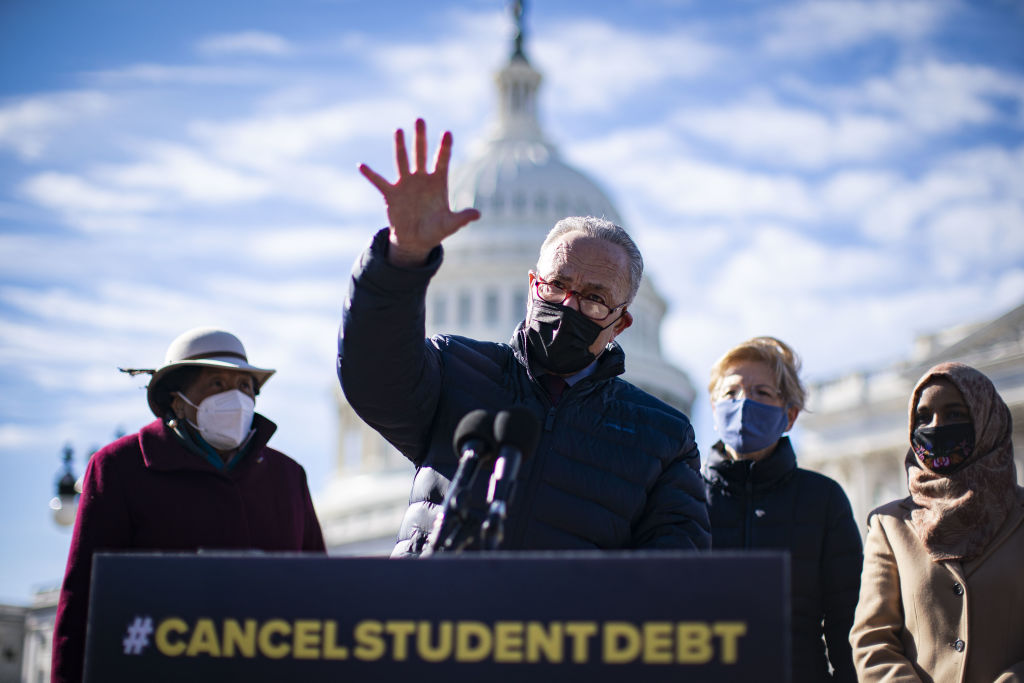
In the months leading up to President Joe Biden’s inauguration, we heard numerous calls for the federal government to cancel at least some outstanding student debt as a means of stimulating the economy and addressing the unfair burden higher education policies have placed on two generations of young people. On Feb. 4, a group of democratic lawmakers led by Senate Majority Leader Charles Schumer (N.Y.) and Sen. Elizabeth Warren (Mass.) called again on President Biden to forgive up to $50,000 in federally held student debt per borrower. As they have done in the past, we expect skeptics to argue that student loan forgiveness is misdirected because Americans with college degrees have been “less devastated by the economic effects of COVID-19 than their non-college-educated counterparts.” But that analysis misunderstands both who holds student debt and who has been most deeply affected by the pandemic.
Let’s take a look:
Those with some college education but no degree
Fewer than half of Americans who start a college degree finish. That means many people have student loans without the earnings advantages a completed degree provides. This group has been hit particularly hard by COVID-19. In a PEW survey from September the largest group of adults to say they or someone in their household had lost a job or wages due to COVID was adults with some college education but no degree. This same group is one of the most likely to struggle with student debt. Prior to COVID, adults who began college but did not finish were three times more likely to default on student loans than borrowers who completed a degree.
Workers in industries that can’t go remote
The professions hardest hit by COVID-19 are those that simply cannot go remote: retail, restaurants, and other service sector jobs including “nonessential” healthcare. While not all of these are sectors where degrees are required, they are also not classic “blue collar” jobs where degrees and college experience are rare. For example, one study found 49 percent of retail workers hold student debt.
Healthcare workers
Private healthcare workers (for example, home health aides and vocational nurses) are also in a high-debt industry. Healthcare workers have been split between those on the frontlines of the COVID-19 health crisis and those who have experienced significant layoffs because of the pandemic. In either case, they are likely to hold student debt. Private healthcare workers with student debt hold an average of $75,366, more than twice the national average. And their debt-to-income ratio is far higher than the average borrower; on average student loan payments make up almost 10 percent of health workers monthly income.
Young people under 30
Young people have been hit particularly hard by COVID; over 50 percent of adults under 30 reported job loss or pay cuts in their household due to COVID. This is also the group holding the largest amount of student debt, with about one-third of all young people under 30 holding debt. Furthermore, adults under 30 have reported having the most difficulty paying bills during COVID, perhaps unsurprising because they have had the least amount of time to save.
Black and Latinx people
At this point, it is widely known that both the student loan crisis and the COVID-19 economic crisis have had disproportionate impacts on Black and brown people. But it’s worth reviewing the numbers because on both counts they are so striking. As of August 2020, the unemployment rate among young Black workers was 24.7 percent, as compared to 11.9 percent for young white workers. Compared to white workers, Black workers overall are 5 percent more likely to report layoffs and wage cuts as a result of COVID, and Latinx workers are a full 15 percent more likely. Turning to student loans, 90 percent of Black and 72 percent of Latinx students take on student debt, compared to just 66 percent of white students. Even in the best of times, Black and Latinx borrowers struggle to pay off loans when compared to their white peers because they make less upon graduating.
Women
Meanwhile, women accounted for all of the jobs lost in the U.S. in December. Women, especially Black and brown women, have had a particularly tough time during the COVID-19 recession because they are concentrated in the sectors that have experienced the greatest job loss and because they have had to take on extra caregiving responsibilities as childcare options have disappeared. At the same time, two-thirds of outstanding student loan debt is held by women. Women also struggle to pay off loans because they make less in the job market, which means that doubly discriminated against Black and brown women face the steepest challenge in paying off student loans.
Cancellation is by no means sufficient to address the student debt crisis—which predates the pandemic—or reach all of the people the pandemic has hurt. But people who make arguments that canceling student debt would miss those the pandemic touched do not understand the breadth of either the student debt crisis or the current economic crisis. Cancelling student debt could quickly and directly benefit millions who need help now.
More Must-Reads From TIME
- The 100 Most Influential People of 2024
- Coco Gauff Is Playing for Herself Now
- Scenes From Pro-Palestinian Encampments Across U.S. Universities
- 6 Compliments That Land Every Time
- If You're Dating Right Now , You're Brave: Column
- The AI That Could Heal a Divided Internet
- Fallout Is a Brilliant Model for the Future of Video Game Adaptations
- Want Weekly Recs on What to Watch, Read, and More? Sign Up for Worth Your Time
Contact us at letters@time.com